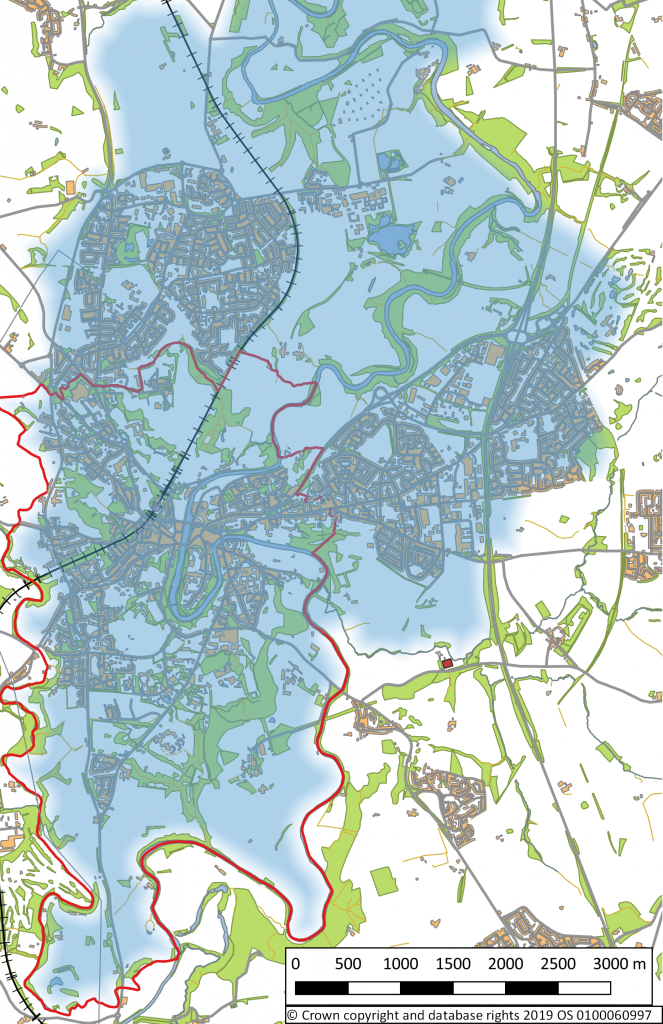Vision
4.156 Durham City will have a range of housing types to meet the needs of a sustainable mix of local residents and students living in harmony.
Objectives
4.157 The objectives of this theme are:
- To change the imbalance towards student accommodation back to a sustainable, balanced community;
- To promote housing designed for the needs of older people and for people with disabilities;
- To promote affordable housing for all sectors of the community, but particularly for families with children and young people starting out.
Context
4.158 Durham City’s setting in a surrounding green bowl is of paramount importance. Development of all kinds should be encouraged up to its physical limits. Major physical constraints within the City include the River Wear, its floodplain and its gorge. The scale and design of new buildings need to respect the City’s heritage and topography, especially regarding the World Heritage Site and the two Conservation Areas. These special Durham factors require that the best use is made of every piece of land within the urban area and especially the development of ‘brownfield’ land and the protection of green and attractive open spaces. The over-riding consideration that applies to all development proposals in Our Neighbourhood, including all forms of residential development, is that there shall be no harm to the historic environment, most notably the setting of the World Heritage Site.
4.159 When work started on the Neighbourhood Plan there were sites within the urban area capable of providing over 1,500 additional dwellings. However, many of these have subsequently been approved for the construction of Purpose Built Student Accommodation. Since 2012 a number of sites in Our Neighbourhood including several specifically identified at the time in the County Council’s SHLAA that could have been for long-term residents have been developed as private PBSAs, i.e.:
- Elvet Studios (Green Lane) 112 studio apartments
- City Block (formerly The Village @ The Viaduct) (Ainsley Street) 223 beds, in cluster and studio apartments
- Ward Court (formerly Neville’s Cross Club) 36 apartments
- Chapel Heights 198 beds
- St Giles Studios (110 Gilesgate) 109 studio flats
- Kepier Court (Mayorswell Close) 214 rooms, a mixture of cluster apartments and studios
- Ustinov College at Sheraton Park (formerly Neville House and Sheraton House) 418 beds, in cluster and studio apartments
- Duresme Court (formerly Berendsen Laundry) 277 studio flats
- Rushford Court (formerly County Hospital) 363 beds
- Houghall Court, East Durham College’s Houghall campus, 222 beds in cluster and studio apartments
4.160 Other PBSA sites could have been for commercial activities, i.e.:
- Dun Holm House, The Riverwalk 253 beds in cluster and studio apartments
- Student Castle, Lower Claypath 473 beds in cluster and studio apartments, under construction
- Back Silver Street 56 beds, but construction not yet started
- The Three Tuns 168 beds, but construction not yet started
4.161 The few remaining areas of land potentially suitable for housing development are therefore extremely precious; it is imperative that the Neighbourhood Plan provides development policies that enable such areas of land within Our Neighbourhood to contribute as much as possible to the provision of appropriate new dwellings for Durham City as a whole.
4.162 One of the strongest concerns expressed in consultations has been the ‘studentification’ of former family housing areas of Durham; the NPPF (para. 62) expects planning policies to aim to create mixed and balanced communities and (para. 91) to achieve healthy, inclusive and safe places. The severe imbalance in parts of Durham City is damaging to community relations, to quality of life and to the future sustainability of schools, shops and other services and facilities. In 2015 the Durham City Neighbourhood Planning Forum collected data on residency in Our Neighbourhood (https://npf.durhamcity.org.uk/themes/housing/property-information/). Most of the information was gathered from public sources, primarily the Valuation Office Agency and Durham County Council, plus estate agents and landlord websites. The database at the time of writing (October 2018) has 2,913 permanent residents’ dwellings, 2,029 student houses and flats, 26 empty properties, 6,209 other rented properties, 1,403 currently unknown occupants, making 6,586 properties in total. The 2,029 student houses and flats represent 30% of all residential properties in Our Neighbourhood, above the 10% figure for a balanced community. It should also be noted that a number of streets in the Viaduct and Crossgate area have student residencies of ~90+%.
4.163 A further issue is that Durham University (2016) has adopted its Masterplan for the growth of Durham University over the next 10 years. This is helpful in displaying Durham University’s aspirations for physical development. This growth will, however, further diminish the very limited availability of sites for various forms of residential development unless sufficient College and Purpose Built Student Accommodation is provided within the University estate. It is welcome therefore, that Durham University has identified land in its ownership for six new Colleges and PBSAs.
4.164 The County Council has provided an estimate of the overall numbers of dwelling units required in Our Neighbourhood, but not for each kind of housing need. To be able to retain the long-term number of residents would need sites for at least 200 additional dwellings at the very minimum (from Appendix C para. C15). The County Council’s estimate at the time of writing (October 2018) (which will be revised in due course) is that a minimum of 1,297 new dwellings are required, comprising 639 on sites now under construction, 120 with planning permission but not yet under construction, 488 with planning permission and included in the emerging County Durham Local Plan, and 50 on a proposed new site (details are in Appendix C). This requirement figure therefore will assist in re-balancing the permanent resident population of Our Neighbourhood.
4.165 The County Council’s figure of the housing requirement for Our Neighbourhood is in effect the supply of new dwellings ‘in the pipeline’ and is thereby automatically sufficient. Additional suitable sites would be useful in case of non-delivery of some of the approved sites and would provide flexibility and a contingency provision. Accordingly, further sites, however small, have been sought and these are included in Policy D1.
Map 6: Durham City Local Plan Monitoring Area
4.166 The Neighbourhood Plan does set out qualitative needs: the County’s population age structure is projected to shift dramatically (Office for National Statistics, 2016b), with the numbers aged 75 and over increasing by 67% from being 8.6% of the total population in 2014 to 13.3% in 2035 (in the 2016 household projections the figures are an increase of 58% from 8.7% of the total population in 2016 to 13% of the total population in 2035 (Office for National Statistics, 2018b)). This makes the provision of suitable accommodation for older people a particular priority. Nevertheless, there are other categories of provision that will be needed, including students, families with children, professionals and people starting out in the housing market (NPPF, para. 61).
Justification
4.167 This justification refers to the Housing theme as a whole. Additional, specific justification for each housing policy is given with the policy itself.
4.168 The results of the Forum priority survey looking at the public’s views about what is good, bad and needs to change about the City (Durham City Neighbourhood Planning Forum, 2015) emphasised housing as a key issue. In particular, the responses indicate that there is an urgent need to redress the huge imbalance towards student accommodation, and the various problems this causes and to provide more housing (e.g. affordable housing; housing for families of various kinds including families with children; older people; and young professionals). The particular importance of ensuring provision for families with children is in order to restore and sustain community balance, inclusiveness and sustainability, notably with regard to school places and children’s and parent’s facilities.
4.169 The NPPF (para. 67) states the need for the local Local Planning Authority to identify a sufficient supply and mix of specific, deliverable sites (the Strategic Housing Land Availability Assessment (SHLAA)). The NPPF’s aims are to meet household and population projections, address the need for all types of housing including affordable housing, address the needs of different groups in the community (including families with children and older people), and contribute to the objective of creating mixed and balanced communities . However, the Local Planning Authority should also protect the Green Belt (NPPF para. 133 to 136) and encourage reuse of brownfield land (NPPF para. 117). These national planning policies apply not just to the Local Planning Authority but to all relevant plan-makers and decision-takers.
4.170 The White Paper ‘Fixing our broken housing market’ (Department for Communities and Local Government, 2017a) and the Government Response to consultation comments (Ministry of Housing, Communities and Local Government, 2018) aim to boost housing supply and, over the long term, create a more efficient housing market. The Government proposes to prioritise the use of brownfield land, incentivise housing for rent, encourage the smaller development firms, discourage ‘land-banking’ and promote good design.
4.171 The Sustainable Communities Strategy for County Durham 2014-2030 (County Durham Partnership, 2014) has a section ‘Altogether greener’ with the aim of promoting sustainable design and protecting Durham’s heritage.
4.172 The Durham City Regeneration Masterplan (Durham County Council, 2014) and its update (Durham County Council, 2016c) have a number of implementation projects and actions relevant to housing in Our Neighbourhood (a subset of the Durham City area covered by the Masterplan), i.e. ensuring services are in place including schools, and planning for housing allocations. The Masterplan update notes what has been delivered and outlines key future activities. Completed projects include the introduction of an Article 4 direction and a policy framework with which to determine student accommodation proposals. Housing allocations are set out in the prevailing Local Plan, and the Neighbourhood Plan seeks to supplement these to provide flexibility and contingency in case of non-delivery.
Planning Policies and Proposals for Land Use
4.173 The policies related to this theme are:
- Policy D1: Land for Residential Development
- Policy D2: Purpose Built Student Accommodation (PBSA)
- Policy D3: Student Accommodation in Houses in Multiple Occupation (HMO)
- Policy D4: Housing for Older People and People with Disabilities
- Policy D5: Affordable Housing
- Policy D6: Building Housing to the Highest Standards
Next section: Policy D1: Land for Residential Development



